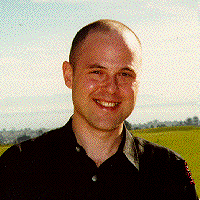![[Currents header graphic]](/homeart/currents_header.gif)
![[Currents header graphic]](/homeart/currents_header.gif)
November 10, 1997

|
|
Alva Noë
|
A person born blind can tell the difference between a sphere and a cube by touch. Were this person suddenly able to see, would she be able to distinguish the two forms by sight? This is the crux of a puzzle that philosophers have been debating for centuries, according to assistant professor of philosophy Alva Noë. Noë will explore this question in connection with broader questions in the philosophy of perception in an upcoming talk.
His talk, "Mind and Vision," is part of the 1997-98 Humanities Lecture Series, sponsored jointly by the Humanities Division and the Museum of Art and History. It takes place from 7 to 8 p.m. on Thursday, November 13, at the Museum of Art and History at the McPherson Center, 705 Front St. The talk is free and open to the public. A reception follows.
Noë will discuss theories of vision and how such theories reflect philosophical conceptions of the nature of the mind. The talk, which will not be technical, will ask questions about how the visual system works and will focus on the nature of spatial vision and the relationship between vision and action.
Noë's area of research is philosophy of the mind. His work combines traditional philosophical methods and concerns with more recent developments in cognitive science and artificial intelligence. Before coming to UCSC last year, he was a research associate at Tufts University's Center for Cognitive Studies under the direction of Daniel Dennett. During the 1995-96 academic year, he was a member of a research team at MIT's Artificial Intelligence Laboratory working to create a conscious humanoid robot. For more information, call (408) 459-2696 or (408) 459-1964.